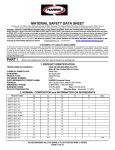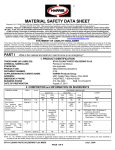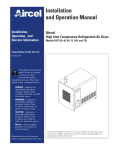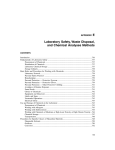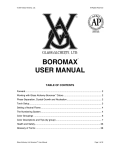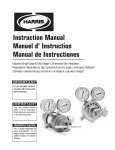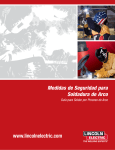Download Lincoln Electric NICK61POP Use and Care Manual
Transcript
® MATERIAL SAFETY DATA SHEET Prepared to U.S. OSHA, CMA, ANSI and Canadian WHMIS Standards .This Material Safety Data Sheet is offered pursuant to OSHA’s Hazard Communication Standard (29 CFR 1910.1200). Other government regulations must be reviewed for applicability to these products. WARNING: PRODUCT COMPONENTS PRESENT HEALTH AND SAFETY HAZARDS. READ AND UNDERSTAND THIS MATERIAL SAFETY DATA SHEET (M.S.DS.). ALSO, FOLLOW YOUR EMPLOYER’S SAFETY PRACTICES. This product may contain Chromium and/or Nickel which are listed by OSHA, NTP, or IARC as being a carcinogen or potential carcinogen. Use of this product may expose you or others to fumes and gases at levels exceeding those established by the American Conference of Governmental Industrial Hygienists (ACGIH) or the Occupational Safety and Health Administration (OSHA) The information contained herein relates only to the specific product. If the product is combined with other materials, all component properties must be considered. BE SURE TO CONSULT THE LATEST VERSION OF THE MSDS. MATERIAL SAFETY DATA SHEETS ARE 513-754-2000 www.harrisproductsgroup.com AVAILABLE FROM HARRIS PRODUCTS GROUP [email protected] STATEMENT OF LIABILITY-DISCLAIMER To the best of the Harris Products Group knowledge, the information and recommendations contained in this publication are reliable and accurate as of the date prepared. However, accuracy, suitability, or completeness are not guaranteed, and no warranty, guarantee, or representation, expressed or implied, is made by Harris Products Group as to the absolute correctness or sufficiency of any representation contained in this and other publications; Harris Products Group assumes no responsibility in connection therewith; nor can it be assumed that all acceptable safety measures are contained in this and other publications, or that other or additional measures may not be required under particular or exceptional conditions or circumstances . Data may be changed from time to time. PART I What is the material and what do I need to know in an emergency? 1. PRODUCT IDENTIFICATION TRADE NAME (AS LABELED): LEAD FREE SOLDERS: STAY-BRITE STAY-SAFE 50 NICK STAY-BRITE ROSIN CORE BRIDGIT 85/15 CHEMICAL NAME/CLASS: SYNONYMS: PRODUCT USE: DOCUMENT NUMBER: SUPPLIER/MANUFACTURER'S NAME: ADDRESS: EMERGENCY PHONE: BUSINESS PHONE: DATE OF PREPARATION: STAY-BRITE 8 SPEEDY 95/5 & 95/5 ROSIN CORE* Solder Alloy Not Applicable Metal Soldering 0125 HARRIS PRODUCTS GROUP 4501 Quality Place, Mason, Ohio 45040 CHEMTREC: 1-800-424-9300 513-154-2000 FAX 513-754-8778 August 13, 2010 2. NOMINAL COMPOSITION and INFORMATION ON INGREDIENTS NOMINAL COMPOSITION WEIGHT % FOR WIRES PRODUCT NAME BRIDGIT Ag Sb Cu Sn 0.05-0.15 4.5-5.5 2.5-3.5 Balance 0.15-0.25 3.5-4.5 Balance 0.15-0.25 2.5-3.5 Balance 0.05-0.15 NICK SPEEDY STAY-BRITE 3.4-3.8 Balance STAY-BRITE 8 5.0-6.0 Balance STAY-BRITE ROSIN CORE 3.4-3.8 Balance STAY-SAFE 50 0.5 3.0 0.5 85/15 95/5 & 95/5 ROSIN CORE 5.0 LEAD FREE SOLDERS MSDS Zn Balance 1.50 85.0 15.0 95.0 EFFECTIVE DATE: June 21, 2002 PAGE 1 OF 10 Ni ROSIN CORE COMPOSITION ELEMENT WEIGHT (% of Core Weight) WEIGHT (% of Total Solder Weight) Activated Rosin 2.6-3.9% 96.1-97.4% 2. NOMINAL COMPOSITION and INFORMATION ON INGREDIENTS (Continued) WIRE COMPOSITION: CHEMICAL NAME CAS # EXPOSURE LIMITS IN AIR ACGIH-TLV TWA STEL 3 3 mg/m mg/m OSHA-PEL TWA STEL 3 3 mg/m mg/m OTHER IDLH 3 mg/m 3 mg/m Antimony & exposure compounds, as Sb 7440-36-0 0.5 NE 0.5 NE 50 NIOSH REL: TWA = 0.5 DFG MAKS: TWA = 0.5 (Antimony, elemental measured as the Inhalable fraction of the aerosol) PEAK = 10 MAK, 30 min., average value Copper (exposure limits are for copper fume, as Copper) 7440-50-8 0.2 NE 0.1 NE 100 NIOSH RELs: TWA 1 = (dust); 0.1 (fume) DFG MAKs: TWA = 0.1 (fume-Respirable fraction); 1 (dusts & mists-inhalable fraction) PEAK = 2 MAK, 30 min., average value Carcinogen: EPA-D (dusts & mists) Nickel, Elemental metal 7440-02-0 1.5, A5 (Inhalable Fraction) (Not Suspected as a Human Carcinogen) NE 1 NE 10 NIOSH REL: TWA = 0.015 Carcinogen: IARC-2B, MAK-1, NIOSH-X, NTP-R, TLV-A5 Silver The following exposure limits are for “Silver, Metal”. 7440-22-4 0.1 NE 0.01 NE 10 NIOSH REL TWA = 0.01 (dust) DFG MAKs: TWA = 0.01 (Inhalable Fraction) PEAK = 2MAK, 5 min., momentary value (Inhalable Fraction) Tin The following exposure limits are for “Tin, Metal”. 7440-31-5 2 NE 2 NE 100 NIOSH REL: TWA = 2 Zinc Exposure limits given are for Zinc oxide, Fume & Dust 7440-66-6 5 (fume) 10 (dust) 10 (fume) 5 (fume) 5 (total dust) 15 (dust, respirable dust) 5 (dust, respirable dust, Vacated 1989 PEL) 10 (fume, Vacated 1989 PEL) 500 NIOSH RELs: TWA = 5 (dust & fume) STEL = 10 (fume), 15 (ceiling, 15 min., dust) DFG MAK: TWA = 1.5 (Respirable Fraction) Carcinogen: EPA-D Carcinogen: EPA-D NE = Not Established. See Section 16 for Definitions of Terms Used. 3 NOTE (1): The ACGIH has an established exposure limit for Brazing Fumes, Not Otherwise Classified. The Threshold Limit Value is 5 mg/m . NIOSH classifies brazing fumes as carcinogens. NOTE (2): ALL WHMIS required information is included in appropriate sections based on the ANSI Z400.1-1998 format. This product has been classified in accordance with the hazard criteria of the CPR and the MSDS contains all the information required by the CPR. LEAD FREE SOLDERS MSDS EFFECTIVE DATE: June 21, 2002 PAGE 2 OF 10 2. NOMINAL COMPOSITION and INFORMATION ON INGREDIENTS (Continued) ROSIN CORE COMPOSITION: CHEMICAL NAME CAS # EXPOSURE LIMITS IN AIR ACGIH-TLV TWA STEL 3 3 mg/m mg/m WW Rosin The following exposure limits are for “Rosin Core Solder decomposition products, as resin acidscolophony” 8050-09-7 Sensitizer, reduce exposure as low as possible. TWA 3 mg/m OSHA-PEL STEL 3 mg/m IDLH 3 mg/m NE NE NE NE OTHER 3 mg/m DFG MAK: Danger of sensitization of the skin NE = Not Established. See Section 16 for Definitions of Terms Used. 3 NOTE (1): The ACGIH has an established exposure limit for Brazing Fumes, Not Otherwise Classified. The Threshold Limit Value is 5 mg/m . NIOSH classifies brazing fumes as carcinogens. NOTE (2): ALL WHMIS required information is included in appropriate sections based on the ANSI Z400.1-1998 format. This product has been classified in accordance with the hazard criteria of the CPR and the MSDS contains all the information required by the CPR. 3. HAZARD IDENTIFICATION EMERGENCY OVERVIEW: These products consist of gray to silver-colored, odorless wires, which may have a plastic core through the center. There is no immediate health hazard associated with the wire product. The plastic core of these products contains a sensitizer; prolonged or repeated exposure to this plastic can cause respiratory and skin allergy-like reactions. Nickel, a component of the Bridgit®, and Nick® wires, is a suspect carcinogen. Though the wire is not flammable, if involved in a fire and exposed to extremely high temperatures, harmful fumes containing Tin, Silver, Antimony and Copper and a variety of metal oxides may be generated. These products are not reactive under normal circumstances of use. Emergency responders must wear the proper personal protective equipment suitable for the situation to which they are responding. SYMPTOMS OF OVER-EXPOSURE BY ROUTE OF EXPOSURE: During soldering operations, the most significant routes of exposure are inhalation, and contact of the skin and eyes. INHALATION: If any exposure to these fumes does occur, however, the main health effect will be irritation of the nose, throat, and other tissues of the respiratory system. Inhalation of copper oxide and zinc oxide (components of this product) fumes can cause metal fume fever. Initial symptoms of metal fume fever can include a metallic or sweet taste in the mouth, dryness or irritation of the throat, and coughing. Later symptoms (after 4-48 hours) can include sweating, shivering, headache, fever, chills, thirstiness, muscle aches, nausea, vomiting, weakness, and tiredness. Repeated over-exposures, via inhalation, to the dusts or fumes generated by these products during soldering operations may have adverse effects on the lungs with possible pulmonary edema and emphysema (life-threatening lung injuries). Exposure to large quantities of the plastic core component of these products may cause irritation of the nose and respiratory system. Repeated or prolonged inhalation of Rosin, a component of some of the plastic core of these products, can cause allergy-like reactions (i.e. wheezing and asthma). CONTACT WITH SKIN or EYES: Contact of the wire form of these products with skin is not anticipated to be irritating. Symptoms of skin over-exposures to the fumes or rosin core of these products may include irritation and redness; prolonged or repeated skin over-exposures may lead to dermatitis. Contact of the liquid core of these products with the skin can cause allergic reactions (i.e. rashes and inflammation of the skin). Contact with the wire form of these products can be physically damaging to the eye. Fumes generated during soldering operations can be irritating to the skin and eyes. Symptoms of eye over-exposure include pain, redness, irritation, and tearing. Contact with the molten core solder will burn contaminated skin or eyes. SKIN ABSORPTION: No component of these products can be absorbed through the skin. INGESTION: Not applicable. LEAD FREE SOLDERS MSDS EFFECTIVE DATE: June 21, 2002 PAGE 3 OF 10 3. HAZARD IDENTIFICATION (Continued) INJECTION: Though not a likely route of occupational exposure for these products, injection of these products (via punctures or lacerations in the skin) may cause local reddening, tissue swelling, and discomfort. HEALTH EFFECTS OR RISKS FROM EXPOSURE: An Explanation in Lay Terms. Symptoms associated with overexposure to these products, and the fumes generated during soldering operations, are as follows: ACUTE:. Inhalation of copper oxide and zinc oxide fumes can cause metal fume fever. Inhalation of large amounts of particulates generated by these products during metal processing operations can result in pneumoconiosis (a disease of the lungs). Contact with the molten solder will burn contaminated skin or eyes. CHRONIC: Chronic skin over-exposure to the fumes of these products generated during soldering operations may produce dermatitis (red, inflamed skin). Chronic skin contact or ingestion of dusts, salts, or fumes of Silver (a component of some these products) can result in a condition known as Argyria. This condition is marked by a bluish appearance of the skin and eyes. The liquid core of these products contains a sensitizer, prolonged or repeated exposure to this plastic can cause respiratory and skin allergy-like reactions. Nickel, a component of some of these products, is a suspect carcinogen. Refer to Section 11 (Toxicological Information) for further information. TARGET ORGANS: respiratory system. PART II For Fumes: ACUTE: Skin and eyes, CHRONIC: Skin, respiratory system. HAZARDOUS MATERIAL IDENTIFICATION SYSTEM HEALTH 1 (BLUE) FLAMMABILITY REACTIVITY (RED) (YELLOW) PROTECTIVE EQUIPMENT EYES RESPIRATORY 0 HANDS See Section 8 0 X BODY See Section 8 For routine industrial applications for rods See Section 16 for Definition of Ratings What should I do if a hazardous situation occurs? 4. FIRST-AID MEASURES Victims of chemical exposure must be taken for medical attention. Rescuers should be taken for medical attention, if necessary. Take copy of label and MSDS to health professional with victim. SKIN EXPOSURE: If the fumes or plastic core of the product irritates the skin, begin decontamination with running water. Victim must seek medical attention if any adverse reaction occurs. If molten solder contaminates the skin, immediately begin decontamination with cold, running water. Minimum flushing is for 15 minutes. Victim must seek immediate medical attention. EYE EXPOSURE: If the product’s fumes, or plastic core enters the eyes, open victim's eyes while under gentle running water. Use sufficient force to open eyelids. Have victim "roll" eyes. Minimum flushing is for 15 minutes. If molten solder contaminates the eyes, immediately begin decontamination with running water. Minimum flushing is for 15 minutes. Victim must seek immediate medical attention. INHALATION: If fumes of these products are inhaled, remove victim to fresh air. If necessary, use artificial respiration to support vital functions. INGESTION: If swallowed call physician immediately! Do not induce vomiting unless directed by medical personnel. Rinse mouth with water if person is conscious. Never give fluids or induce vomiting if person is unconscious, having convulsions, or not breathing. MEDICAL CONDITIONS AGGRAVATED BY EXPOSURE: Skin disorders may be aggravated by prolonged overexposures to these products. RECOMMENDATIONS TO PHYSICIANS: Treat symptoms and eliminate over-exposure. LEAD FREE SOLDERS MSDS EFFECTIVE DATE: June 21, 2002 PAGE 4 OF 10 5. FIRE-FIGHTING MEASURES FLASH POINT: Not flammable. AUTOIGNITION TEMPERATURE: Not flammable. FLAMMABLE LIMITS (in air by volume, %): Lower (LEL): Not applicable. Upper (UEL): Not applicable. FIRE EXTINGUISHING MATERIALS: Water Spray: YES Carbon Dioxide: YES Foam: YES Halon: YES Other: Any "ABC" Class. Dry Chemical: YES UNUSUAL FIRE AND EXPLOSION HAZARDS: When involved in a fire, this material may melt and produce fumes containing tin, zinc, copper compounds and a variety of metal oxides. When the plastic core is heated, the solvent will evaporate and the rosin core may be degraded to produce aliphatic aldehydes, acids and terpines. The molten material can present a significant thermal hazard to fire-fighters. Explosion Sensitivity to Mechanical Impact: Not sensitive. Explosion Sensitivity to Static Discharge: Not sensitive. NFPA RATING FLAMMABILITY 0 0 0 HEALTH REACTIVITY OTHER See Section 16 for Definition of Ratings SPECIAL FIRE-FIGHTING PROCEDURES: Not applicable. 6. ACCIDENTAL RELEASE MEASURES SPILL AND LEAK RESPONSE: Not applicable. PART III How can I prevent hazardous situations from occurring 7. HANDLING and STORAGE WORK PRACTICES AND HYGIENE PRACTICES: As with all chemicals, avoid getting these products ON YOU or IN YOU. Wash hands after handling these products. Do not eat or drink while handling this material. Use ventilation and other engineering controls to minimize potential exposure to these products. STORAGE AND HANDLING PRACTICES: All employees who handle this material should be trained to handle it safely. Avoid breathing fumes of these products during soldering operations. Packages of these products must be properly labeled. If these products are used during soldering operations, it is recommended that the requirements of the Federal Occupational Safety and Health Welding and Cutting Standard (29 CFR 1910 Subpart Q) and the safety standards of the American National Standards Institute for welding and cutting (ANSI Z49.1) be followed. 8. EXPOSURE CONTROLS - PERSONAL PROTECTION VENTILATION AND ENGINEERING CONTROLS: Use with adequate ventilation to ensure exposure limits are below those provided in Section 2 (Composition and Information on Ingredients). Use a mechanical fan or vent area to outside. Prudent practice is to ensure eyewash/safety shower stations are available near areas where these products are used. RESPIRATORY PROTECTION: Maintain airborne contaminant concentrations below exposure limits listed in Section 2 (Composition and Information on Ingredients). If respiratory protection is needed (i.e. a Weld Fume Respirator, or Air-Line Respirator for welding in confined spaces), U.S. Federal OSHA Standard (29 CFR 1910.134), applicable U.S. State regulations, or the Canadian CSA Standard Z94.4-93 and applicable standards of Canadian Provinces. Respiratory Protection is recommended to be worn during welding operations. Oxygen levels below 19.5% are considered IDLH by OSHA. In such atmospheres, use of a full-facepiece pressure/demand SCBA or a full facepiece, supplied air respirator with auxiliary self-contained air supply is required under OSHA’s Respiratory Protection Standard (1910.134-1998). For additional information, the following respirator selection guidelines from NIOSH for Tin (the main component of these products) are provided: RESPIRATORY EQUIPMENT: CONCENTRATION: Dust and mist respirator. Up to 10 mg/m3: Dust and mist respirator except single-use and quarter-mask respirator; or Supplied Air Up to 20 mg/m3: Respirator (SAR). (continued on following page) LEAD FREE SOLDERS MSDS EFFECTIVE DATE: June 21, 2002 PAGE 5 OF 10 8. EXPOSURE CONTROLS - PERSONAL PROTECTION (Continued) RESPIRATORY PROTECTION (continued): CONCENTRATION: RESPIRATORY EQUIPMENT: SAR operated in a continuous-flow mode; or powered air-purifying respirator with dust Up to 50 mg/m3: and mist filter(s). Full-facepiece respirator with high-efficiency particulate filter(s); or full-facepiece Self-Contained Up to 100 mg/m3: Breathing Apparatus (SCBA); or full-facepiece SAR. Emergency or Planned Entry into Unknown Concentrations or IDLH Conditions: Positive pressure, full-facepiece SCBA; or positive pressure, full-facepiece SAR with an auxiliary positive pressure SCBA. Escape: Full-facepiece respirator with high-efficiency particulate filter(s); or escape-type SCBA. EYE PROTECTION: Safety glasses. When these products are used in conjunction with soldering, wear safety glasses, goggles or face-shield with filter lens of appropriate shade number (per ANSI Z49.1-1988, “Safety in Welding and Cutting”), as necessary. HAND PROTECTION: Wear gloves for routine industrial use. When these products are used in conjunction with soldering, wear gloves that protect from sparks and flame (per ANSI Z49.1-1988, “Safety in Welding and Cutting”), as necessary. BODY PROTECTION: Use body protection appropriate for task (i.e. leather apron). 9. PHYSICAL and CHEMICAL PROPERTIES The following information is for Tin, the main component of these products: RELATIVE VAPOR DENSITY (air = 1): Not applicable. EVAPORATION RATE (nBuAc = 1): Not applicable. SPECIFIC GRAVITY (water = 1): 7.28 FREEZING/MELTING POINT: 232C (450F) SOLUBILITY IN WATER: Insoluble. BOILING POINT: 2270C (4118F) VAPOR PRESSURE, mm Hg @ 20 °C: Approximately 0. pH: Not applicable. ODOR THRESHOLD: Not applicable. COEFFICIENT OF OIL/WATER DISTRIBUTION (PARTITION COEFFICIENT): Not applicable. The following information is for the product: APPEARANCE, ODOR AND COLOR: These products are a gray to silver, odorless metal wires, which may have a plastic core running through the middle. HOW TO DETECT THIS SUBSTANCE (warning properties): The appearance is a distinctive characteristic of these products. 10. STABILITY and REACTIVITY STABILITY: Stable. DECOMPOSITION PRODUCTS: A tin and zinc compounds and a variety of metal oxides. MATERIALS WITH WHICH SUBSTANCE IS INCOMPATIBLE: These products are not compatible with strong acids (i.e. nitric acid), strong bases (i.e. sodium hydroxide), sulfur, and strong oxidizers (i.e. hydrogen peroxide). HAZARDOUS POLYMERIZATION: Will not occur. CONDITIONS TO AVOID: Avoid uncontrolled exposure to extreme temperatures and incompatible chemicals. PART IV Is there any other useful information about this material? 11. TOXICOLOGICAL INFORMATION TOXICITY DATA: The following human toxicological data are available for the components of these products. Other data for animals are available but are not presented in this Material Safety Data Sheet. SILVER: 3 TCLo (inhalation, human) = 1 mg/m . COPPER: TDLo (oral, human) = 120 g/kg; gastrointestinal tract effects SUSPECTED CANCER AGENT: The components of these products are listed as follows: COPPER: EPA-D (Not Classifiable as to Human Carcinogenicity) NICKEL, ELEMENTAL, METAL: IARC-2B (Possibly Carcinogenic to Humans), MAK-1 (Substances which Cause Cancer in Man), NIOSH-X, (Carcinogen Defined with no Further Categorization); NTP-R (Reasonably Anticipated to be a Human Carcinogen), ACGIH TLV-A5 (Not Suspected as a Human Carcinogen) SILVER: EPA-D (Not Classifiable as to Human Carcinogenicity) ZINC: EPA-D (Not Classifiable as to Human Carcinogenicity (inadequate human and animal evidence of carcinogenicity or no data available) The other components of these products are not found on the following lists: FEDERAL OSHA Z LIST, NTP, CAL/OSHA, IARC, and therefore are not considered to be, nor suspected to be cancer-causing agents by these agencies. LEAD FREE SOLDERS MSDS EFFECTIVE DATE: June 21, 2002 PAGE 6 OF 10 11. TOXICOLOGICAL INFORMATION (Continued) IRRITANCY OF PRODUCT: The fumes of these products, generated during soldering operations, can be irritating to contaminated skin and eyes. SENSITIZATION TO THE PRODUCT: Some of these products contain Rosin, which is an allergen and can cause respiratory and skin reactions (i.e. asthma, rashes, and welts). Rare cases of allergic contact dermatitis have been reported in people working with copper dust. Nickel is also in some of these product, and has been reported to cause sensitization effects in sensitive individuals, however due to the low concentration in the product, this is not anticipated to be a significant hazard. REPRODUCTIVE TOXICITY INFORMATION: Listed below is information concerning the effects of these products and their components on the human reproductive system. Mutagenicity: These products are not reported to produce mutagenic effects in humans. Animal mutation data are available for Nickel (a component of these products); these data were obtained during clinical studies on specific animal tissues exposed to high doses of this compound. Embryotoxicity: These products are not reported to produce embryotoxic effects in humans. Teratogenicity: These products are not reported to cause teratogenic effects in humans. Clinical studies on test animals exposed to relatively high doses of Copper and Nickel (a component of these products) indicate teratogenic effects. Reproductive Toxicity: These products are not reported to cause reproductive effects in humans. Clinical studies on test animals exposed to relatively high doses of Copper (a component of these products) indicate adverse reproductive effects. A mutagen is a chemical, which causes permanent changes to genetic material (DNA) such that the changes will propagate through generational lines. An embryotoxin is a chemical, which causes damage to a developing embryo (i.e. within the first eight weeks of pregnancy in humans), but the damage does not propagate across generational lines. A teratogen is a chemical, which causes damage to a developing fetus, but the damage does not propagate across generational lines. A reproductive toxin is any substance, which interferes in any way with the reproductive process. BIOLOGICAL EXPOSURE INDICES: Currently, Biological Exposure Indices (BEIs) have not been determined for the components of these products. 12. ECOLOGICAL INFORMATION ALL WORK PRACTICES MUST BE AIMED AT ELIMINATING ENVIRONMENTAL CONTAMINATION. ENVIRONMENTAL STABILITY: These products, if released into the environment, may cause local heavy metal contamination with potential impact on plant, animal, and aquatic life. The metal is not biodegradable, and will persist in the environment for an extended period of time. The following environmental data are available for the components of these products. ANTIMONY: Solubility: Insoluble in water. Antimony tends to hydrolyze and precipitate out as an oxide. In experiments the approximate half-life for antimony initial phase was 40 hour for antimony trioxide and 30 hour for antimony dust, for the second phase half-lives of 20-40 days for antimony trioxide and antimony dust were observed. Antimony can be accumulated to toxic levels by marine life. COPPER: Copper may concentrate to toxic level in the food chain SILVER: Solubility: Insoluble in water. Many silver salts are only slightly soluble and so silver cations will rapidly be reduced to lower levels. The Biological Half-Life for silver is a few days for animals and up to 50 days for humans. TIN: Solubility: Insoluble in water. ZINC: Solubility: Insoluble in water. Biological Half-Life for normal humans 162-500 days. Bioconcentration: The Bioconcentration Factor in edible portions of Crassostrea virgina, adult oyster) is 16,700 (total zinc). EFFECT OF MATERIAL ON PLANTS or ANIMALS: Heavy metal toxicity effects on plants may result in poor plant growth, poor appearance, and loss of plant vitality. This material may be harmful to animal life. Specific data on test animals are available, but are not presented in this Material Safety Data Sheet. EFFECT OF CHEMICAL ON AQUATIC LIFE: Discharge of these products into water may cause local heavy metal contamination, and may cause permanent contamination of the bottom of the affected body of water. All work practices must minimize potential or actual releases to the environment. The following aquatic toxicity data are available for the components of these products. COPPER: Copper is concentrated by plankton by 1000 or more. concentrate to toxic level in the food chain Copper may ZINC: Odorless zinc poisoning causes inflamed gills in fish. Laboratory studies of Atlantic salmon, rainbow trout, carp, and goldfish have shown avoidance reactions by these fish to zinc in water SILVER: 0.1 ppm is toxic to bacteria and aquatic life. Discharge into marine waters should not exceed 1/20 of 96 hour LC50, 0.25-0.025 mg/kg/day. LEAD FREE SOLDERS MSDS EFFECTIVE DATE: June 21, 2002 PAGE 7 OF 10 13. DISPOSAL CONSIDERATIONS PREPARING WASTES FOR DISPOSAL: Waste disposal must be in accordance with appropriate Federal, State, and local regulations. These products, if unaltered by use, may be disposed of by treatment at a permitted facility or as advised by your local hazardous waste regulatory authority. EPA WASTE NUMBER: Wastes of these products should be analyzed for Toxicity Characteristic Leach Procedure chemicals, as follows: Silver: D011, Regulated Level: 5.0 mg/L. 14. TRANSPORTATION INFORMATION THIS MATERIAL IS NOT HAZARDOUS (Per 49 CFR 172.101) BY THE U.S. DEPARTMENT OF TRANSPORTATION. PROPER SHIPPING NAME: Not applicable. HAZARD CLASS NUMBER and DESCRIPTION: Not applicable. UN IDENTIFICATION NUMBER: Not applicable. PACKING GROUP: Not applicable. DOT LABEL(S) REQUIRED: Not applicable. NORTH AMERICAN EMERGENCY RESPONSE GUIDEBOOK NUMBER, 2000: Not applicable. MARINE POLLUTANT: No component of this product is designated as a marine pollutant by the Department of Transportation (49 CFR 172.101, Appendix B). TRANSPORT CANADA TRANSPORTATION OF DANGEROUS GOODS REGULATIONS: This material is not considered as dangerous goods, per regulations of Transport Canada. 15 REGULATORY INFORMATION ADDITIONAL U.S. REGULATIONS: U.S. SARA REPORTING REQUIREMENTS: The components of these products are subject to the reporting requirements of Sections 302, 304 and 313 of Title III of the Superfund Amendments and Reauthorization Act, as follows: CHEMICAL NAME Silver Tin Zinc Nickel Antimony Copper SARA 302 (40 CFR 355, Appendix A) No No No No No No SARA 304 (40 CFR Table 302.4) Yes No Yes Yes Yes Yes SARA 313 (40 CFR 372.65) Yes No Yes (fume or dust) Yes Yes Yes U.S. SARA THRESHOLD PLANNING QUANTITY: There are no specific Threshold Planning Quantities for the components of this product. The default Federal MSDS submission and inventory requirement filing threshold of 10,000 lbs (4,540 kg) therefore applies, per 40 CFR 370.20. U.S. TSCA INVENTORY STATUS: The components of these products are listed on the TSCA Inventory. U.S. CERCLA REPORTABLE QUANTITY (RQ): Silver = 1,000 lbs (454 kg), Copper = 5000 lbs (2270 kg), Nickel = 100 lbs 45.4 kg), Zinc = 1000 lbs (454 kg), Antimony = 5000 lbs (2270 kg). (Note: No reporting is required if the diameter of the metal equals or exceeds 100 micrometers). U.S. STATE REGULATORY INFORMATION: The components of these products are covered under specific State regulations, as denoted below: Alaska-Designated Toxic and Hazardous Substances: Copper Fume, Dust, & Mist, Nickel, Tin, Antimony compounds, Silver metal soluble compounds. California-Permissible Exposure Limits for Chemical Contaminants: Copper, Nickel, Tin, Antimony, and Silver. Florida-Substance List: Copper Fume, Dust, & Mist, Nickel, Tin, Zinc, Antimony, Silver. Illinois-Toxic Substance List: Copper, Nickel, Zinc, Antimony, and Silver. Kansas-Section 302/313 List: Copper, Nickel, Zinc, Antimony and compounds. Massachusetts-Substance List: Copper, Nickel, Tin, Zinc, Antimony, and Silver. Michigan Critical Materials Register: Copper, Nickel, Antimony, Silver, and Zinc. Minnesota-List of Hazardous Substances: Copper Dust & Mists, Nickel, Tin, Antimony and compounds, Silver. Missouri-Employer Information/Toxic Substance List: Copper, Nickel, Tin, Antimony, and Silver. New Jersey-Right to Know Hazardous Substance List: Copper, Nickel, Tin, Zinc, Antimony, and Silver. North Dakota-List of Hazardous Chemicals, Reportable Quantities: Copper, Nickel, Zinc, Antimony, and Silver. LEAD FREE SOLDERS MSDS Pennsylvania-Hazardous Substance List: Copper, Nickel, Tin, Zinc, Antimony, and Silver. Rhode Island-Hazardous Substance List: Copper Fume, Dust, & Mist, Nickel, Tin, Zinc, Antimony and compounds, Silver. Texas-Hazardous Substance List: Copper Fume, Nickel, and Antimony, Silver metal and soluble compounds. West Virginia-Hazardous Substance List: Copper Fume, Nickel, and Antimony, Silver metal and soluble compounds. Wisconsin-Toxic and Hazardous Substances: Copper Fume, Nickel, and Antimony, Silver metal and soluble compounds. EFFECTIVE DATE: June 21, 2002 PAGE 8 OF 10 15 REGULATORY INFORMATION (Continued) ADDITIONAL U.S. REGULATIONS (continued): CALIFORNIA PROPOSITION 65: Nickel is a component of some of these products. Nickel is on the California Proposition 65 lists. WARNING: Some of these products contain chemical(s) known to the State of California to cause cancer. LABELING (Precautionary Statements): CAUTION! FUMES MAY BE HARMFUL IF INHALED. FUMES CAN CAUSE SKIN AND EYE IRRITATION. FUMES OR CONTACT WITH PLASTIC CORE MAY CAUSE ALLERGIC RESPIRATORY AND SKIN REACTIONS. MOLTEN SOLDER CAN CAUSE THERMAL BURNS. CANCER HAZARD. CONTAINS MATERIAL WHICH CAN CAUSE CANCER. Avoid inhalation of fumes. Avoid contact with skin, eyes, and clothing. Wash thoroughly after handling. Use in well-ventilated area. Wear gloves, safety glasses (or colored-absorptive lens), body protection and respiratory protection, as appropriate, for welding or soldering operations. FIRST-AID: In case of skin or eye contact with fumes, flush skin with copious amounts of water. In case of thermal burn, flush area with water for 15 minutes. Remove contaminated clothing and shoes. If inhaled, remove to fresh air. If not breathing, give artificial respiration. If breathing is difficult, give oxygen. If ingested, do not induce vomiting. Seek medical attention if adverse reaction occurs, or in the event of a thermal burn. IN CASE OF FIRE: Use water spray, foam, dry chemical or CO2. IN CASE OF SPILL: Sweep-up or vacuum spilled material, absorb spilled liquid with inert materials. If molten material is released, allow it to cool before clean-up. Place in a suitable container. Consult Material Safety Data Sheet before use. WARNING: PROTECT yourself and others. Read and understand this information. FUMES AND GASES can be hazardous to your health. ARC RAYS can injure your eyes and burn skin. ELECTRIC SHOCK can kill. HEAT RAYS (INFRARED RADIATION) from flame or hot metal can injure eyes. Before use, read and understand the manufacturer’s instructions. Material Safety Data Sheets (MSDSs), and your employer’s safety policies. Keep your head out of the fumes. Use enough ventilation, exhaust at the arc, or both, to keep fumes and gases from your breathing zone and the general area. FOR MAXIMUM SAFETY, BE CERTIFIED FOR AND WEAR A RESPIRATOR AT ALL TIMES WHEN WELDING OR BRAZING Wear correct eye, ear, and body protection. Do not touch live electrical parts. See American National Standard Z49.1 Safety in Welding, Cutting, and Allied Processes, published by the American Welding Society, 550 N.W. LeJeune Road, Miami, Florida 33126. OSHA Safety and Health Standards, 29 CFR 1910, available from the U.S. Government Printing Office, Superintendent office, P.O. Box 371954, Pittsburgh, PA 15250-7954. DO NOT REMOVE THIS INFORMATION ADDITIONAL CANADIAN REGULATIONS: CANADIAN DSL/NDSL INVENTORY STATUS: The components of these products are on the DSL Inventory. OTHER CANADIAN REGULATIONS: Not applicable. CANADIAN ENVIRONMENTAL PROTECTION ACT (CEPA) PRIORITIES SUBSTANCES LISTS: The components of these products are not on the CEPA Priorities Substances Lists. CANADIAN WHMIS SYMBOLS: For plastic core: D2B: Poisonous and Infectious Material/Other Toxic Effects. LEAD FREE SOLDERS MSDS EFFECTIVE DATE: June 21, 2002 PAGE 9 OF 10 16. OTHER INFORMATION DATE OF PRINTING: August 26, 2010 This Material Safety Data Sheet is offered pursuant to OSHA’s Hazard Communication Standard (29 CFR 1910.1200). Other government regulations must be reviewed for applicability to these products. The information contained herein relates only to the specific product. If the product is combined with other materials, all component properties must be considered. To the best of the Harris Products Group knowledge, the information and recommendations contained in this publication are reliable and accurate as of the date of issue. However, accuracy, suitability, or completeness are not guaranteed, and no warranty, guarantee, or representation, expressed or implied, is made by Harris Products Group as to the absolute correctness or sufficiency of any representation contained in this and other publications; Harris Products Group assumes no responsibility in connection therewith; nor can it be assumed that all acceptable safety measures may not be required under particular or exceptional conditions or circumstances. Data may be changed from time to time. Be sure to consult the latest edition. DEFINITIONS OF TERMS A large number of abbreviations and acronyms appear on a MSDS. Some of these which are commonly used include the following: CAS #: This is the Chemical Abstract Service Number which uniquely identifies each constituent. FLAMMABILITY LIMITS IN AIR: EXPOSURE LIMITS IN AIR: Much of the information related to fire and explosion is derived from the ACGIH - American Conference of Governmental Industrial Hygienists, a National Fire Protection Association (NFPA). Flash Point - Minimum professional association which establishes exposure limits. temperature at which a liquid gives off sufficient vapors to form an ignitable IARC-International Agency for Research on Cancer TLV - Threshold Limit mixture with air. Autoignition Temperature: The minimum temperature Value - an airborne concentration of a substance which represents required to initiate combustion in air with no other source of ignition. LEL conditions under which it is generally believed that nearly all workers may be the lowest percent of vapor in air, by volume, that will explode or ignite in the repeatedly exposed without adverse effect. The duration must be presence of an ignition source. UEL - the highest percent of vapor in air, by considered, including the 8-hour Time Weighted Average (TWA), the 15volume, that will explode or ignite in the presence of an ignition source. minute Short Term Exposure Limit, and the instantaneous Ceiling Level (C). Skin absorption effects must also be considered. TOXICOLOGICAL INFORMATION: OSHA - U.S. Occupational Safety and Health Administration. Human and Animal Toxicology: Possible health hazards as derived from PEL - Permissible Exposure Limit - This exposure value means exactly the human data, animal studies, or from the results of studies with similar same as a TLV, except that it is enforceable by OSHA. The OSHA compounds are presented. Definitions of some terms used in this section Permissible Exposure Limits are based in the 1989 PELs and the June, are: LD50 - Lethal Dose (solids & liquids) which kills 50% of the exposed 1993 Air Contaminants Rule (Federal Register: 58: 35338-35351 and 58: animals; LC50 - Lethal Concentration (gases) which kills 50% of the exposed 40191). Both the current PELs and the vacated PELs are indicated. The animals; ppm concentration expressed in parts of material per million parts 3 phrase, “Vacated 1989 PEL,” is placed next to the PEL which was vacated of air or water; mg/m concentration expressed in weight of substance per by Court Order. IDLH - Immediately Dangerous to Life and Health - This volume of air; mg/kg quantity of material, by weight, administered to a test level represents a concentration from which one can escape within 30subject, based on their body weight in kg. Other measures of toxicity include minutes without suffering escape-preventing or permanent injury. The DFG TDLo, the lowest dose to cause a symptom and TCLo the lowest MAK is the Republic of Germany’s Maximum Exposure Level, similar to the concentration to cause a symptom; TDo, LDLo, and LDo, or TC, TCo, U.S. PEL. NIOSH is the National Institute of Occupational Safety and LCLo, and LCo, the lowest dose (or concentration) to cause lethal or toxic Health, which is the research arm of the U.S. Occupational Safety and effects. Cancer Information: The sources are: IARC - the International Health Administration (OSHA). NIOSH issues exposure guidelines called Agency for Research on Cancer; NTP - the National Toxicology Program, Recommended Exposure Levels (RELs). When no exposure guidelines are RTECS - the Registry of Toxic Effects of Chemical Substances, OSHA and established, an entry of NE is made for reference. NTP- National CAL/OSHA. IARC and NTP rate chemicals on a scale of decreasing Toxicology Program potential to cause human cancer with rankings from 1 to 4. Subrankings (2A, 2B, etc.) are also used. Other Information: BEI - ACGIH Biological HAZARD RATINGS: Exposure Indices, represent the levels of determinants which are most likely HAZARDOUS MATERIALS IDENTIFICATION SYSTEM: Health Hazard: 0 to be observed in specimens collected from a healthy worker who has been (minimal acute or chronic exposure hazard); 1 (slight acute or chronic exposed to chemicals to the same extent as a worker with inhalation exposure hazard); 2 (moderate acute or significant chronic exposure exposure to the TLV. Ecological Information: EC is the effect hazard); 3 (severe acute exposure hazard; onetime overexposure can result concentration in water. BCF = Bioconcentration Factor, which is used to in permanent injury and may be fatal); 4 (extreme acute exposure hazard; determine if a substance will concentrate in lifeforms which consume onetime overexposure can be fatal). Flammability Hazard: 0 (minimal contaminated plant or animal matter. Coefficient of Oil/Water Distribution hazard); 1 (materials that require substantial pre-heating before burning); 2 is represented by log Kow or log Koc and is used to assess a substance’s (combustible liquid or solids; liquids with a flash point of 38-93C [100behavior in the environment. 200F]); 3 (Class IB and IC flammable liquids with flash points below 38C REGULATORY INFORMATION: [100F]); 4 (Class IA flammable liquids with flash points below 23C [73F] This section explains the impact of various laws and regulations on the and boiling points below 38C [100F]. Reactivity Hazard: 0 (normally material. U.S.: EPA is the U.S. Environmental Protection Agency. DOT is stable); 1 (material that can become unstable at elevated temperatures or the U.S. Department of Transportation. SARA is the Superfund which can react slightly with water); 2 (materials that are unstable but do not Amendments and Reauthorization Act. TSCA is the U.S. Toxic Substance detonate or which can react violently with water); 3 (materials that can Control Act. CERCLA (or Superfund) refers to the Comprehensive detonate when initiated or which can react explosively with water); 4 Environmental Response, Compensation, and Liability Act. Labeling is per (materials that can detonate at normal temperatures or pressures). the American National Standards Institute (ANSI Z129.1). CANADA: 0 NATIONAL FIRE PROTECTION ASSOCIATION: Health Hazard: CEPA is the Canadian Environmental Protection Act. WHMIS is the (material that on exposure under fire conditions would offer no hazard Canadian Workplace Hazardous Materials Information System. TC is beyond that of ordinary combustible materials); 1 (materials that on Transport Canada. DSL/NDSL are the Canadian Domestic/Non-Domestic exposure under fire conditions could cause irritation or minor residual injury); Substances Lists. The CPR is the Canadian Product Regulations. This 2 (materials that on intense or continued exposure under fire conditions section also includes information on the precautionary warnings which could cause temporary incapacitation or possible residual injury); 3 appear on the materials package label. (materials that can on short exposure could cause serious temporary or residual injury); 4 (materials that under very short exposure causes death or major residual injury). Flammability Hazard and Reactivity Hazard: Refer to definitions for “Hazardous Materials Identification System”. LEAD FREE SOLDERS MSDS EFFECTIVE DATE: June 21, 2002 PAGE 10 OF 10










